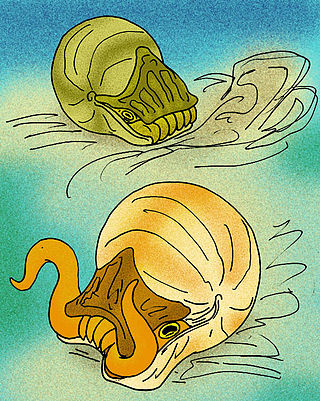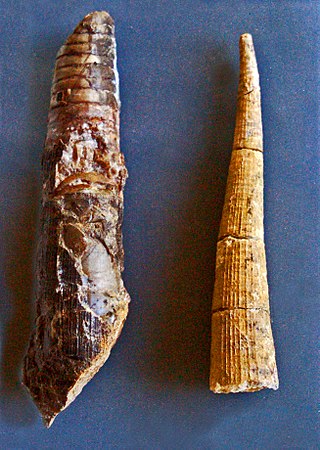
Dactylioceras was a widespread genus of ammonites from the Lower Jurassic period, approximately 180 million years ago (mya).

Ancyloceras is an extinct genus of heteromorph ammonites found throughout the world during the Lower Cretaceous, from the Lower Barremian epoch until the genus extinction during the Lower Aptian.

Arcestes is a genus of extinct ceratitid ammonites found in Triassic-aged marine strata.

Argonauticeras is an extinct ammonoid cephalopod genus that lived during the latter part of the Early Cretaceous, included in the Lytoceratida and found in lower and possibly middle Aptian marine sediments. It has been thought of as a subgenus of Ammonoceratites.

Ceratites is an extinct genus of ammonite cephalopods. These nektonic carnivores lived in marine habitats in what is now Europe, during the Triassic, from the upper-most Anisian to the lower Ladinian age.

Kionoceras is an extinct nautiloid cephalopod genus included in the orthocerid family Kionoceratidae with scattered worldwide distribution from the Middle Ordovician to the Lower Permian. Kionoceratids are orthocerids with prominent longitudinal ornamentation on their shells, sometimes augmented by secondary transverse ornamentation. Orthocerids are, of course, prehistoric nautiloides with generally straight and elongate shells, mostly with central or subcentral siphuncles.
Endolobus is an extinct genus from the nautiloid order, Nautilida. Nautiloids are a subclass of shelled cephalopods that were once diverse and numerous but are now represented by only a handful of species, including Nautilus. Endolubus is included in the family Koninckioceratidae which is part of the superfamily Tainoceratoidea.
Valhallites is an extinct genus in the nautiloid order Nautilida which includes the living Nautilus found in the tropical western Pacifiic. Valhalites belongs to the Koninckioceratidae, a family in the Tainoceratoidea, a nautilid superfamily.
Tylonautilus is an extinct genus in the nautiloid order Nautilida from the Lower Carboniferous of Europe and Permian of Japan.
Stearoceras is an extinct genus of prehistoric nautiloids from the Lower Pennsylvanian - Lower Permian with a fair worldwide distribution.(Kümmel 1964)

Macroscaphites is an extinct cephalopod genus included in the Ammonoidea that lived during the Barremian and Aptian stages of the Early Cretaceous. Its fossils have been found throughout most of Europe and North Africa.

Calycoceras is an extinct genus of cephalopods belonging to the subclass Ammonoidea and family Acanthoceratidae that lived during the Cenomanian stage of the Late Cretaceous, 100-94 Mya. Their shells had ornate ribs.

Lopha is a genus of marine bivalve molluscs in the family Ostreidae.

Pleuroceras is a genus of ammonite from the lower Jurassic, upper Pliensbachian.
Kilianella is a genus of the ammonite family Neocomitidae. The shell of Kilianella is evolute with a slightly grooved venter and covered by strong, gently flexious, single or bifurcating ribs.
Saxoceras is a genus of very evolute schlotheimiid ammonoids from the Lower Jurassic.
Dagnoceras is a ceratitid ammonite from the Lower Triassic that has a basically evolutute, discoidal shell with an arched venter and ceratitic sutures. The Treatise 1957 includes it in the Meekoceratidae although it has since been placed in the Dinaritidae.

Harpoceras is an extinct genus of ammonite belonging to the family Hildoceratidae. These cephalopods existed in the Jurassic period, during the Toarcian age from the Falciferum zone to the Commune subzone of the Bifrons zone. They were fast-moving nektonic carnivores.
Radstockiceras is an extinct genus of lower Jurassic ammonite that lived from Oxynotum zone of upper Sinemurian to Raricostatum zone of lower Pliensbachian. Shells of these animals were oxycone and involute with umbilicus that took maximum of 12% of diameter in the case of outer whorls. On inner whorls, venter has been sharp, but then it became rounded. Faint ribs had falcoid shape, but sometimes, ribs could absent. Shells could have been large in their size. Suture has been very complex, similar to Oxynoticeras, but culmination at umbilical margin has been missing. Genus has been named after town of Radstock, in Somerset.
Reynesocoeloceras is genus of ammonite that lived during the lower Pliensbachian stage of early Jurassic, ammonite zones Ibex—Davoei.










